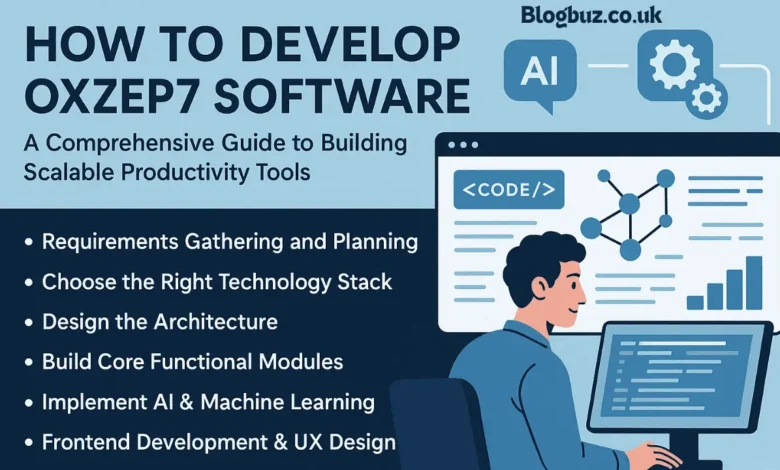How to Develop Oxzep7 Software: A Comprehensive Guide to Building Scalable Productivity Tools

In today’s fast-paced digital environment, developing efficient, secure, intelligent software is more crucial than ever. The rising demand for innovative productivity platforms has led to the emergence of solutions like Oxzep7 software. Whether you’re a developer, project manager, or business owner, understanding how to develop Oxzep7 software can be a game-changer. This guide dives deep into everything you need to know about building and deploying this cutting-edge productivity and workflow automation platform.
What is Oxzep7 Software?
Oxzep7 is a versatile software suite designed to improve workflow efficiency and promote seamless collaboration through artificial intelligence and automation. It supports multiple industries, including healthcare, education, finance, and tech startups. Built primarily in Python, Oxzep7 stands out for its modularity, cross-platform compatibility, and integration capabilities with other tools like Trello, Asana, and Microsoft Teams.
Core Features of Oxzep7:
- AI-driven task management
- Real-time collaboration tools
- Scalable modular architecture
- Data encryption and robust security
- Cross-platform support (Windows, macOS, Linux)
- Seamless third-party integrations
Understanding these features is the first step to developing Oxzep7 software that delivers real business value.
Step-by-Step Guide to Develop Oxzep7 Software
Requirements Gathering and Planning
Begin with a comprehensive needs assessment:
- Identify Pain Points: What productivity challenges are you solving?
- Define Objectives: Set measurable goals for your software.
- Conduct Market Research: Analyze existing solutions and identify your software’s unique value proposition (UVP).
Develop detailed user personas and create user stories to map expected user journeys.
Choose the Right Technology Stack
While Python remains the primary backend language for Oxzep7, your technology stack may also include:
- Frontend: React.js, Vue.js, or Angular for interactive user interfaces
- Backend: Flask or Django for rapid development
- Database: PostgreSQL or MongoDB for secure and scalable data storage
- Cloud: AWS, Azure, or Google Cloud for deployment
- DevOps: Docker, Jenkins, and Kubernetes for CI/CD and containerization
Design the Architecture
Microservices vs Monolithic
Oxzep7 typically benefits from a microservices architecture, which offers:
- Improved scalability
- Independent module updates
- Easier maintenance and testing
Database Design
Focus on a schema that allows:
- Fast querying
- Secure storage
- Real-time analytics integration
Security Measures
- End-to-end encryption
- Role-based access control (RBAC)
- Two-factor authentication (2FA)
- Automated data backups
Build Core Functional Modules
Some essential modules to include:
- User Authentication & Authorization
- Dashboard & Reporting Tools
- Task and Workflow Automation
- Communication Channels (Chat, Video calls, etc.)
- Integration APIs (for Slack, Zoom, Dropbox, etc.)
Release MVP (Minimum Viable Product) versions of each module using agile methodology. Then, perform iterative testing and refinements.
Implement AI & Machine Learning
AI is a cornerstone of Oxzep7. Consider these components:
- Natural Language Processing (NLP) for task recognition
- Machine Learning Models for Predictive Analytics
- AI Chatbots for virtual assistance
Open-source libraries like TensorFlow, PyTorch, and spaCy can accelerate development.
Frontend Development & UX Design
Focus on:
- Responsiveness: Ensure UI adapts across devices
- Accessibility: Comply with WCAG standards
- User Experience (UX): Simple, intuitive workflows and minimalistic design
Testing and Quality Assurance
Develop a comprehensive testing strategy that includes:
- Unit Testing: Individual modules
- Integration Testing: Modules working together
- Load Testing: Scalability under stress
- User Acceptance Testing (UAT): Real user feedback
Deployment and Scaling
Use DevOps practices to automate your deployment pipeline:
- Set up CI/CD with Jenkins or GitHub Actions
- Containerize with Docker
- Use Kubernetes for orchestration
- Deploy on scalable cloud infrastructure (AWS, Azure)
Post-Deployment Monitoring and Maintenance
Implement tools like:
- New Relic or Datadog for performance monitoring
- Sentry or Rollbar for error tracking
- Google Analytics for user behavior insights
Continuously collect user feedback and deploy updates based on analytics and feature requests.
SEO Benefits of Developing Oxzep7 Software
Creating Oxzep7 software not only offers productivity benefits but also opens up SEO opportunities:
- Niche Targeting: Focus on specific industries or functions
- Content Marketing: Use how-to guides, use cases, and whitepapers to drive traffic
- Backlink Opportunities: Collaborate with blogs and tech forums to build authority
Common Challenges and Solutions
Challenge: Integration complexity
Solution: Use standardized REST APIs and OAuth for seamless integration
Challenge: Data privacy concerns
Solution: Adhere to GDPR, HIPAA, and other data protection standards
Challenge: AI model accuracy
Solution: Regularly retrain models with fresh, diverse datasets
Future Enhancements for Oxzep7
- IoT Compatibility: Allow data collection from smart devices
- Voice Command Features: Integrate with Alexa, Siri
- Blockchain Integration: For immutable data trails
- Extended Analytics: Advanced reporting and KPIs
- Community Forum: Build a developer/user community for collaborative improvements
Final Thoughts
Developing Oxzep7 software is a multifaceted process that blends technology, strategy, and user-centered design. Following the structured approach demonstrated in this guide, you can build a high-impact tool that improves workflows and adapts to evolving market needs.
FAQS
What makes Oxzep7 software different from other productivity tools?
Oxzep7 stands out due to its AI-driven task automation, modular architecture, robust security features, and seamless integration with third-party tools like Trello, Slack, and Microsoft Teams.
Which industries can benefit most from Oxzep7 software?
Oxzep7 is versatile and benefits multiple sectors, including healthcare, education, finance, and tech startups, by streamlining workflows, enhancing collaboration, and improving operational efficiency.
Why is a microservices architecture recommended for Oxzep7?
A microservices architecture enhances scalability, simplifies maintenance, and allows independent deployment of different modules, making it ideal for dynamic, high-growth platforms like Oxzep7.
How does AI enhance the functionality of Oxzep7 software?
AI features in Oxzep7 include natural language processing for task management, predictive analytics through machine learning, and intelligent virtual assistants for real-time user support and automation.
What are the key security features included in Oxzep7?
Key security measures include end-to-end encryption, role-based access control (RBAC), two-factor authentication (2FA), and compliance with standards like GDPR and HIPAA.
You May Also Read: Starship CodeGen Agent: Revolutionizing the Software Development Landscape




